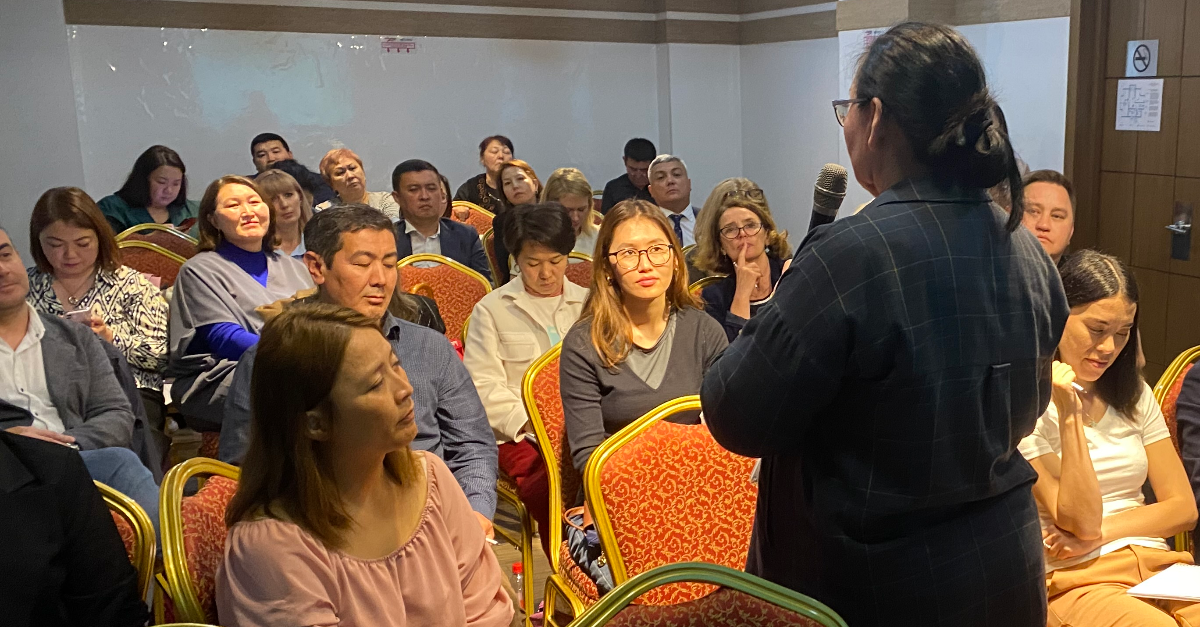Workplace-specific courses for companies and employees are also to be developed in Kyrgyzstan. The GO model of the SVEB can support this. Cäcilia Märki, Head of Basic Skills, reports on her stay in Bishkek.
Report: Cecilia Märki
On the morning of May 20th, 50 people arrived at the Smarthotel in Bishkek for the start of a 5-day training session to get to know the Swiss GO model. They were invited by the CHeber Skills Development Project, a 12-year initiative of the Swiss Embassy and Helveta’s Kyrgyzstan. The project started in December 2023 and aims to support a market for non-formal education in cooperation with business associations and private and public education providers. The GO model of the SVEB aims to provide the know-how for job-specific courses for Kyrgyz companies and employees.
Basic skills in Kyrgyzstan
The promotion of adult basic skills is not an explicit issue in Kyrgyzstan. There is hardly any migration to Kyrgyzstan, according to reports, and Russian and Kyrgyz are spoken and written. The national language is Kyrgyz, and Russian is not well spoken, especially in the countryside. What I keep hearing is that the participants do not have any practical experience following a professional qualification, which is a great challenge for companies. During the course of the training, participants quickly confirmed that there is a great need to promote basic literacy, numeracy and ICT skills, particularly in companies.
The 16 participants of the training are employed in business associations or are active as training providers. The training starts with an in-depth presentation of the GO model, the four functions, the GO process, how to deal with the descriptors and the methods of analysis of requirements.
Visit to the textile industry
Equipped with the necessary basics, the participants were able to visit the textile factory outside Bishkek on the third day. Being able to carry out a requirement analysis in a specific factory makes it possible to experience a key element in the GO process in practice. After arriving at the factory, we gather around the big table in the meeting room to identify the needs from the point of view of the CEO of the company. The CEO is open to the results of the observations and impressions of the visitors. He emphasizes that he produces mass-produced goods and that the demands on quality are low. He was unable to identify any specific training needs, but was convinced that middle management in particular needed support. There was no guarantee that a course could actually be implemented, but he was interested in the results of the analyses.
Afterwards, we can visit the different areas of the company: sewing, cutting, packaging and quality control. In three groups, we can visit all departments, observe, photograph and talk to employees.
Working conditions: few breaks
The company produces mass-produced goods on the assembly line for the Russian market. In five parallel “lines”, individual seamers, mainly from Bangladesh and India, execute a single seam in the chord. The seamstresses receive a unit price and earn between 20’000 and 50’000 Som per month (200-500 euros), which corresponds to the average wage in Kyrgyzstan.
As team leaders, brigadier women support the work of the seamstresses, create a production schedule, take care of the correct settings of the sewing machines. Cutting is automated. Using software, a cutting program is created for each product and finally cut to size. Written communications is in Russian. In the morning there is a 15-minute break and 30 minutes for lunch. In the afternoon there is no break until 6.15 p.m. Most of the women come from the surrounding villages. They are picked up by minibuses in the morning and taken home in the evening.
Requirement profiles and location determinations
In the afternoon, the participants gather and structure their impressions of the company. It quickly becomes clear that three requirement profiles are being developed: one for the seamstresses, one for the brigadier and one for the cutting staff. For each of the three fields of action, an impressive number of situations have been collected, prioritised and assigned to the descriptors. Three requirement profiles are created, which serve as a basis for assessing the learning needs of the employees themselves. The participants develop very specific test tasks and interview guides for the three groups of employees in the textile industry. I am impressed with how efficiently the tools of the GO model are used.
The last day is devoted to writing course concepts for the three requirements profiles. Participants work in groups with a template for a course concept and present their offers to an imaginary “Iliad”, the head of the company, with the aim of convincing him of their course concepts.
Feedback: high satisfaction
Satisfaction with the 5-day training is high among the participants. The GO model is very relevant to the needs of Kyrgyzstan and comes at just the right time. It is flexible, has a clearly structured process and in particular the requirements analysis and the location determination are experienced as very useful. They want to continue working with it and adapt it to the needs of Kyrgyzstan for job seekers and vocational qualifications.
What’s next?
The project goals of CHeber are ambitious. By the end of 2027, it plans to have 4,500 courses enrolled in the Skills Development Project. This will require a significant number of partner organisations across the country and trainers to teach the GO model. In their feedback to the CHeber project, the participants give a clear signal that they are ready for further cooperation. The training was a successful start and for me personally a very enriching experience.

